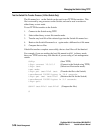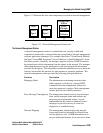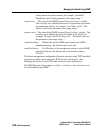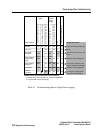
3-54 Switch Management
GigWorks MkII-16 Switch Model MKII-BASE16
59003-01 Rev. A Installer's/User's Manual
Managing the Switch Using SNMP
or graphical representation allowing the administrator to easily diagnose and
manage the nodes and network traffic.
Additionally, agents in the managed nodes can report error conditions (such as
when user-set threshold levels have been exceeded) to the network management
station without waiting to be polled for the information. Using the combined
approach, when a managed node agent generates a trap, the network management
station can query the node for additional information.
Figure 3-16 illustrates the interaction between the SNMP management station and
managed node agent for information exchange.
Figure 3-16 Trap-Directed Polling Data Collection
Community Types
Each SNMP request is signed with an identifier called an SNMP community
name. Although SNMP places no restrictions on the bytes in the community
name, the node agent and management station may place specific restrictions on
the characters that may be used (such spaces, tabs, open square brackets, equal
signs, colons, semicolons, number signs, etc.) or on the length of the string (such
as, up to 32 characters). Three types of communities exist and each can have a
different name.
Community Type Description
Monitor Community This community name grants read access to SNMP MIBs.
For each SNMP query, the network management station
must include the monitor community name in the message.
By default, the monitor community name is set to “public.”
Control Community This name grants read and write access to the MIBs.
Because some MIB objects are read-only, even with the
correct control community name, a network management
station cannot modify the variables contained in the MIB.
By default, the control community is disabled so that MIBs
are not modified accidentally.
Switch
SNMP
Agent
Mgmt
Station
Link A
Link B
Provide status of Link A
and its costs
Link A: Status Up, Cost 5
ALERT! Link B Down


















